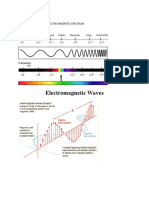What Is Electro Megnatic
What Is Electro Megnatic
Uploaded by
zhungjian586Copyright:
Available Formats
What Is Electro Megnatic
What Is Electro Megnatic
Uploaded by
zhungjian586Original Title
Copyright
Available Formats
Share this document
Did you find this document useful?
Is this content inappropriate?
Copyright:
Available Formats
What Is Electro Megnatic
What Is Electro Megnatic
Uploaded by
zhungjian586Copyright:
Available Formats
t looks like you're asking about "electromagnetic," which might refer to electromagnetic fields,
electromagnetic waves, or the electromagnetic spectrum. Let's break down these concepts for
clarity.
Electromagnetic Fields
An electromagnetic field (EM field) is a physical field produced by electrically charged objects.
It affects the behavior of charged objects in the vicinity of the field. EM fields extend
indefinitely throughout space and describe the electromagnetic interaction. They can be static
(like the field around a permanent magnet or around a stationary charged particle) or dynamic (as
in the case of fields between moving charges).
Electromagnetic Waves
When electric and magnetic fields oscillate together, they form electromagnetic waves, which
propagate through space. These waves are produced by the acceleration of charged particles.
They travel at the speed of light (approximately 299,792 kilometers per second in a vacuum) and
do not require a medium to travel through, distinguishing them from mechanical waves that need
a medium (like air, water, or solids).
Electromagnetic waves carry energy, momentum, and angular momentum away from their
source particle and can transfer those quantities to matter with which they interact.
Electromagnetic Spectrum
The electromagnetic spectrum encompasses all types of electromagnetic radiation, ranging from
very short wavelengths (including gamma and X-rays) to very long wavelengths (including
microwaves and radio waves). The spectrum is typically divided into seven regions, in order of
decreasing frequency and increasing wavelength:
1. Gamma rays: The shortest wavelength EM waves, typically less than 10 picometers. They are
produced by the hottest and most energetic objects in the universe, such as neutron stars and
areas around black holes.
2. X-rays: With wavelengths ranging from about 10 picometers to 10 nanometers, X-rays are used
in medical imaging and also in exploring the cosmos.
3. Ultraviolet (UV) light: Ranging from 10 nm to about 400 nm, UV rays are responsible for
sunburns but are also used in sterilization and fluorescence.
4. Visible light: This narrow band of the spectrum (about 400 to 700 nm) includes all the colors
that the human eye can perceive.
5. Infrared (IR) radiation: Occupying wavelengths from 700 nm to 1 mm, IR is emitted by all
objects at room
You might also like
- Radio Communication Assignment 01Document79 pagesRadio Communication Assignment 01Amila Srimaal GamageNo ratings yet
- Electromagnetic WavesDocument11 pagesElectromagnetic WavesgnanaNo ratings yet
- Science Reviewer 1Document15 pagesScience Reviewer 1Symon MarianoNo ratings yet
- Electromagnetic RadiationDocument10 pagesElectromagnetic RadiationEldsoky DabaNo ratings yet
- Grade 10 ReviewerDocument6 pagesGrade 10 ReviewerDino M PangilinanNo ratings yet
- Science Report Electromagnetic SpectrumDocument24 pagesScience Report Electromagnetic SpectrumJedí BelanoNo ratings yet
- Electromagnetic WavesDocument8 pagesElectromagnetic WavesHafid ZainulNo ratings yet
- Science ReviewerDocument9 pagesScience ReviewerdomslangsakalamNo ratings yet
- Electromagnetic Waves: Vina P. Hipolito Iv-Silvestre Assignment )Document7 pagesElectromagnetic Waves: Vina P. Hipolito Iv-Silvestre Assignment )VhinaP.HipolitoNo ratings yet
- Electromagnetic SpectrumDocument4 pagesElectromagnetic SpectrumDenise Marie Dela TorreNo ratings yet
- Made By: Febrian Nugroho W X - 1 / 15 Sma 2 SemarangDocument14 pagesMade By: Febrian Nugroho W X - 1 / 15 Sma 2 SemarangFebrian Nugroho WinartoNo ratings yet
- Electromagnetic Waves Regions of The EM WavesDocument73 pagesElectromagnetic Waves Regions of The EM WavesJR LubisNo ratings yet
- AS Unit 2-Light and SoundDocument5 pagesAS Unit 2-Light and SoundAli SalamehNo ratings yet
- Lecture 2.1 - EM WavesDocument8 pagesLecture 2.1 - EM WavesAPPLE CAGUNGUN-BELGICANo ratings yet
- 1.1 Electromagnetic SpectrumDocument17 pages1.1 Electromagnetic SpectrumShreyas SvNo ratings yet
- Electromagnetic Waves: Description: Electromagnetic Waves Are Formed When An Electric Field ComesDocument14 pagesElectromagnetic Waves: Description: Electromagnetic Waves Are Formed When An Electric Field Comesj_sachin09No ratings yet
- Electromagnetic SpectrumDocument7 pagesElectromagnetic Spectrummuddasarhussain739No ratings yet
- Electromagnetic WavesDocument74 pagesElectromagnetic WavesJohnNo ratings yet
- C12-Electromagnetic WavesDocument74 pagesC12-Electromagnetic WavesGerald S. FernandezNo ratings yet
- What Are Electromagnetic Waves?Document8 pagesWhat Are Electromagnetic Waves?Jay Marie OcampoNo ratings yet
- Handout 02Document10 pagesHandout 02JAMESNo ratings yet
- EM Waves - UPHDocument20 pagesEM Waves - UPHSHIVA THAVANI100% (1)
- SCH 100 Notes 2013-2014 ALLDocument42 pagesSCH 100 Notes 2013-2014 ALLErick Wangila WanyonyiNo ratings yet
- History: Spectrum IsDocument23 pagesHistory: Spectrum IsMuhamad NurhudayahNo ratings yet
- GRADE10 - Electromagnetic - WavesDocument72 pagesGRADE10 - Electromagnetic - WavesyekcimhadjiamerNo ratings yet
- Electromagnetic WavesDocument10 pagesElectromagnetic WavesJahleel TroupeNo ratings yet
- Biological Effects of Electromagnetic Fields On Human's HealthDocument18 pagesBiological Effects of Electromagnetic Fields On Human's HealthMarina ZaraNo ratings yet
- Electromagnetic Specters: Física Electricidad Y MagnetismoDocument28 pagesElectromagnetic Specters: Física Electricidad Y MagnetismoJeison Fernando Mejia MahechaNo ratings yet
- Regions: The Electromagnetic SpectrumDocument7 pagesRegions: The Electromagnetic SpectrumIrene PontillasNo ratings yet
- General Informatio NDocument15 pagesGeneral Informatio NJenny RoblesNo ratings yet
- 7 Types of Electromagnetic WavesDocument2 pages7 Types of Electromagnetic Wavesvee propaganda100% (1)
- Electromagnetic WavesDocument54 pagesElectromagnetic WavesPortia A. Egken100% (1)
- THE ORIGINAL - Science JMDocument5 pagesTHE ORIGINAL - Science JMpaiynmailNo ratings yet
- Electromagnetic SpectrumDocument43 pagesElectromagnetic SpectrumxunxhineNo ratings yet
- Untitled 2Document6 pagesUntitled 2Faizal DinjoeNo ratings yet
- Electromagnetic Waves Class 12 Physics Notes Chapter 8: History of EMWDocument7 pagesElectromagnetic Waves Class 12 Physics Notes Chapter 8: History of EMWShaku JoshiNo ratings yet
- What Is Electromagnetic WaveDocument5 pagesWhat Is Electromagnetic WaveMico Angelo FernandezNo ratings yet
- Lesson 4 Electromagnetic WavesDocument45 pagesLesson 4 Electromagnetic WavesErica QuirobNo ratings yet
- Electromagnetic Waves and OpticsDocument17 pagesElectromagnetic Waves and Optics2244892No ratings yet
- Electromagnetic SpectrumDocument16 pagesElectromagnetic SpectrumTanish100% (1)
- Science ReviewerDocument19 pagesScience ReviewerAphrodite UnderwoodNo ratings yet
- C12 Electromagnetic WavesDocument48 pagesC12 Electromagnetic WavesRosemarie Cabanilla50% (2)
- Gamma Rays: These Are The Most Energetic and Dangerous Form of ElectromagneticDocument4 pagesGamma Rays: These Are The Most Energetic and Dangerous Form of ElectromagneticmubashirNo ratings yet
- Introduction To Electromagnetic WavesDocument11 pagesIntroduction To Electromagnetic WavesDharshana pjr100% (1)
- Electro Magentic WaveDocument4 pagesElectro Magentic WaveespantomarknowellNo ratings yet
- Jam PresentationDocument7 pagesJam Presentationchinniemarie11No ratings yet
- Waves Packet KEYDocument44 pagesWaves Packet KEYlauraNo ratings yet
- Electromagnetic Waves: By: I Nyoman S. (X-8/09) Raka Pandam G. (X-8/21)Document11 pagesElectromagnetic Waves: By: I Nyoman S. (X-8/09) Raka Pandam G. (X-8/21)Nyoman SuryadinataNo ratings yet
- Science Reviewer QuizDocument4 pagesScience Reviewer Quiz28. Pinera, Yna Angela S.100% (1)
- Investigation Project PhysicsDocument16 pagesInvestigation Project Physicskartikdutt.08No ratings yet
- Alziya Physics ProjectDocument8 pagesAlziya Physics ProjectMohammad AyanNo ratings yet
- Electromagnetic Spectrum Electromagnetic SpectrumDocument12 pagesElectromagnetic Spectrum Electromagnetic SpectrumAsim ZargarNo ratings yet
- Self-Learning Home Task (SLHT)Document12 pagesSelf-Learning Home Task (SLHT)Ryzza Retubado100% (1)
- 2nd Quarter Reviewer in ScienceDocument3 pages2nd Quarter Reviewer in Sciencecali annaNo ratings yet
- Wireless Charging of Mobile PhonesDocument18 pagesWireless Charging of Mobile PhonesChakraPaniNo ratings yet
- Wireless Charging of Mobile PhonesDocument18 pagesWireless Charging of Mobile PhonesChakraPaniNo ratings yet
- PhysicsDocument20 pagesPhysicsMelanie De SousaNo ratings yet
- Physics1101 - Course MaterialDocument332 pagesPhysics1101 - Course MaterialAhmad RazaNo ratings yet
- ELECTROMAGNETIC FIELDS: Exposure is not optional, no one can avoid itFrom EverandELECTROMAGNETIC FIELDS: Exposure is not optional, no one can avoid itNo ratings yet
- Unified Field Theory in a Nutshell1: The Quest for the Theory of EverythingFrom EverandUnified Field Theory in a Nutshell1: The Quest for the Theory of EverythingNo ratings yet
- MomentumDocument2 pagesMomentumzhungjian586No ratings yet
- Laboratory Construction and Operation Program For Sedra III, IV and V, Riyadh East Project (Preliminary Draft)Document9 pagesLaboratory Construction and Operation Program For Sedra III, IV and V, Riyadh East Project (Preliminary Draft)zhungjian586No ratings yet
- What Is Stress and StainDocument1 pageWhat Is Stress and Stainzhungjian586No ratings yet
- Pre Interview FormDocument1 pagePre Interview Formzhungjian586No ratings yet
- Linear MotionDocument2 pagesLinear Motionzhungjian586No ratings yet
- 21 4033 Central Region Library - 2023.08.11Document1,305 pages21 4033 Central Region Library - 2023.08.11zhungjian586No ratings yet
- 21-4020-E000 KEO-SPC-SU-00 - Rev.01Document47 pages21-4020-E000 KEO-SPC-SU-00 - Rev.01zhungjian586No ratings yet
- Sika Aer Air EntrainingDocument2 pagesSika Aer Air Entrainingzhungjian586No ratings yet
- Sapl Roshn DSN RPT 000121Document31 pagesSapl Roshn DSN RPT 000121zhungjian586100% (1)
- Division 01 - General RequirementsDocument154 pagesDivision 01 - General Requirementszhungjian586No ratings yet
- Appendix A - BIM Requirements (RRE-EIR - Project Execution)Document18 pagesAppendix A - BIM Requirements (RRE-EIR - Project Execution)zhungjian586No ratings yet
- S08-001 - Roller Compacted Concrete - USDocument72 pagesS08-001 - Roller Compacted Concrete - USzhungjian586No ratings yet
- Astm C918C918MDocument6 pagesAstm C918C918Mzhungjian586No ratings yet
- Sika Antifreeze 1%Document2 pagesSika Antifreeze 1%zhungjian586No ratings yet
- Specification 2Document4 pagesSpecification 2zhungjian586No ratings yet
- Astm C685C685MDocument9 pagesAstm C685C685Mzhungjian586No ratings yet
- Specification 3Document10 pagesSpecification 3zhungjian586No ratings yet
- ContentsDocument4 pagesContentszhungjian586No ratings yet
- Specification 1Document7 pagesSpecification 1zhungjian586No ratings yet
- Civil Enineer CV 12Document5 pagesCivil Enineer CV 12zhungjian586No ratings yet















































































